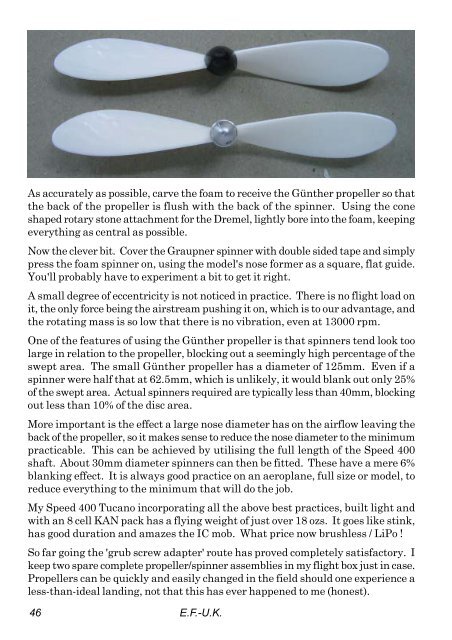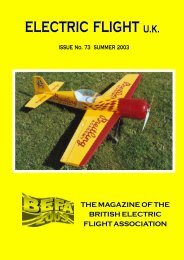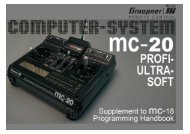Download - British Electric Flight Association
Download - British Electric Flight Association
Download - British Electric Flight Association
Create successful ePaper yourself
Turn your PDF publications into a flip-book with our unique Google optimized e-Paper software.
As accurately as possible, carve the foam to receive the Günther propeller so that<br />
the back of the propeller is flush with the back of the spinner. Using the cone<br />
shaped rotary stone attachment for the Dremel, lightly bore into the foam, keeping<br />
everything as central as possible.<br />
Now the clever bit. Cover the Graupner spinner with double sided tape and simply<br />
press the foam spinner on, using the model's nose former as a square, flat guide.<br />
You'll probably have to experiment a bit to get it right.<br />
A small degree of eccentricity is not noticed in practice. There is no flight load on<br />
it, the only force being the airstream pushing it on, which is to our advantage, and<br />
the rotating mass is so low that there is no vibration, even at 13000 rpm.<br />
One of the features of using the Günther propeller is that spinners tend look too<br />
large in relation to the propeller, blocking out a seemingly high percentage of the<br />
swept area. The small Günther propeller has a diameter of 125mm. Even if a<br />
spinner were half that at 62.5mm, which is unlikely, it would blank out only 25%<br />
of the swept area. Actual spinners required are typically less than 40mm, blocking<br />
out less than 10% of the disc area.<br />
More important is the effect a large nose diameter has on the airflow leaving the<br />
back of the propeller, so it makes sense to reduce the nose diameter to the minimum<br />
practicable. This can be achieved by utilising the full length of the Speed 400<br />
shaft. About 30mm diameter spinners can then be fitted. These have a mere 6%<br />
blanking effect. It is always good practice on an aeroplane, full size or model, to<br />
reduce everything to the minimum that will do the job.<br />
My Speed 400 Tucano incorporating all the above best practices, built light and<br />
with an 8 cell KAN pack has a flying weight of just over 18 ozs. It goes like stink,<br />
has good duration and amazes the IC mob. What price now brushless / LiPo !<br />
So far going the 'grub screw adapter' route has proved completely satisfactory. I<br />
keep two spare complete propeller/spinner assemblies in my flight box just in case.<br />
Propellers can be quickly and easily changed in the field should one experience a<br />
less-than-ideal landing, not that this has ever happened to me (honest).<br />
46<br />
E.F.-U.K.
















